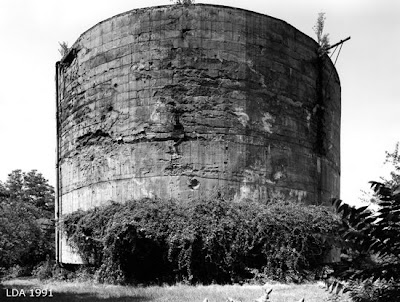
«During a seemingly endless nighttime hypertextual journey through Wikipedia — one that took us from Tempelhof to a crash course on Nazi architecture and to Hitler's imagined future capital, Welthauptstadt Germania, a city that became a ruin without first having existed, and to Albert Speer, whose post-war gardening activities are worth detailing, which we will in a future post, i.e., if we still have the stamina to trudge through his excruciatingly long diary for the few relevant entries, before looping back to the start to then read about the Berlin Airlift, whose infrastructural and spatial organization, including the three air corridors above the blockaded Soviet Occupied Zone, we find so utterly interesting — we discovered the Schwerbelastungskörper.
So what is it?
It's a massive cylindrical block of concrete, standing 18 meters high and weighing in at 12,560 metric tons. It is located in the Berlin neighborhood of Tempelhof, where the eponymous airport is found.
The name is translated as “heavy load-bearing body,” although someone in the discussion page has suggested that “heavy load-exerting body” might be more accurate. It was constructed in 1941 to test how well the marshy ground upon which Berlin sits could handle the massive projects planned for Germania. More specifically, it was built to see how the landscape would react to Hitler's gigantic Triumphal Arch, whose opening would have accommodated Paris' Arc de Triomphe.
The results were not encouraging: The Schwerbelastungskörper sank 7 inches in the three years it was to be used for testing, a maximum depth of 2.5 inches was allowed. Using the evidence gathered by these gargantuan devices, it is unlikely the soil could have supported such structures without further preparation.
Hitler dismissed these findings, perhaps confident that the landscape can be subjugated with fine Teutonic engineering. But Hitler's capital had to wait. There was a war to be waged.»
Via Pruned.


Sem comentários:
Enviar um comentário